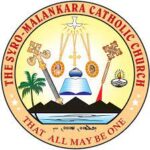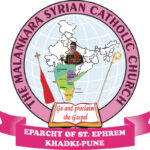The Eparchy of St Ephrem
History
The history of the Church in India begins with the arrival of St.Thomas, the apostle, in India in 52 AD. It paved the way for the foundation of the ancient Christian community in India called the St. Thomas Christians the Malankara Nazranikal. The Church, rooted in the cultural traditions of India, was in contact with the Universal Church through her communion with theChurches of the Middle-East. The indigenous Church remained one with the Catholic Church until the 17th century. But the direct interference of the Western Churches in India through the Portuguese missionaries and their tactful attempt to Latinize the Church of the St. Thomas Christians created aversion among the faithful here and it paved the way for the historical event ‘Coonan Cross Oath‘ in 1653 and the division of the Church into two. The breakaway group in due course got in touch with the Jacobites under the Patriarch of Antioch. This paved the way to the establishment of the Jacobite Church in India..
Ever since the split, there were uninterrupted efforts to re-establish communion with Rome. However it was the movement under the zealous leadership of Mar Ivanios that realized the great reunion of the Malankara Church on 20th September 1930, when the Universal Church received the Malankara Church into the Catholic communion with all its cultural, liturgical, theological, spiritual and disciplinary patrimony. And as later developments, His Holiness Pope Pius XI established the Syro-Malankara Hierarchy and erected the Archieparchy of Trivandrum with the Eparchy of Tiruvalla as its suffragan on 11 June 1932. On 14 February 1958 through the letter (Prot.No.534/53) of the Congregation of the Oriental Churches, the territorial boundaries of the Eparchy of Tiruvalla was extended to the north including the Malabar region of Kerala, the civil districts of Coimbatore and NilgirisandKaroor Taluk in Tiruchirappally District of Tamil Nadu and districts of Mysore, Mandya, Coorg, Hasan, Chickamangalore, Shimoga and South Kanara of Karnataka State.
The establishment of BethanyAshram Pune on 24 October 1955 can be said to be the beginning of the mission of the Malankara Catholic Church outside its canonical territory. From Pune the Bethany Fathers took care of the Malankara Catholic faithful in Mumbai-Pune regions. Soon the Malankara Catholics in other cities of India began to organize themselves as Malankara Catholic Associations. From the beginning of 1970s the Malankara Hierarchy directly took initiative and began sending priests from the Eparchies to these communities. From 1980 these communities began to be erected canonically as personal parishes in the dioceses where they were registered. The Hierarchy gave further support to them appointing Rev. Fr John Berchmans OIC in 1997 as the Co-ordinator of the Malankara Catholics outside the territoriumproprium. Under his untiring leadership the communities got organized strongly under the banner ‘The Malankara Catholic Church Extra Territorial Regions in India (MCCETRI).’
And later on February 2007 Bishop Jacob Mar Barnabas was appointed Apostolic Visitator by Holy Father Pope Benedict XVI. Later the Holy Episcopal Synod of the Syro-Malankara Catholic Church entrusted the pastoral care of the Malankara Catholic faithful of ETRI to Bishop Jacob Mar Barnabas.
For long years, the Malankara Catholic Church had been incessantly attempting to gain all- India jurisdiction to impart the joy of the Gospel to every nook and corner of India. And it was, by divine grace, realized on 26 March 2015 with the erection of the new Exarchate of Khadki in Pune and the new Eparchy of Gurgaon in New Delhi. This is a significant event in the history of Malankara Catholic Church as well as the Church in India. It was for the first time, such a right was granted to a particular oriental church in India.
The Exarchate of Khadki in Pune is named after St. Ephrem and His Holiness Pope Francis appointed as its first Apostolic Exarch, BishopThomas Mar Anthonios Valiyavilayil, OIC, with the title “Bishop of Igilgili.” According to the decision of the Holy Episcopal Synod he continues to hold the office of the Curia Bishop of the Syro-Malankara Catholic Church and the office of the Postulator of the Cause of Canonization of Servant of God Archbishop Mar Ivanios.
The exarchate extends over the entire southern part of India where till then there was no Syro- Malankara ecclesial circumscription, namely, the entire states of Maharashtra, Goa, Andhra Pradesh and Telangana, together with parts of Karnataka and Tamil Nadu. Today the Syro-Malankara presence in the region of the Exarchate consists of 27 parishes or missions. There are 21 priests dedicated to the pastoral care, 13 convents of women religious and about ten schools, including a college for higher studies. The majority of the faithful is found in Mumbai, Pune, Hyderabad, Chennai, Bengaluru, Nashik, Aurangabad and Nagpur. The first Exarch will have his residence and chancery in Khadki, Pune, in the complex which includes St. Mary‘s Malankara Catholic Church, which will serve as cathedral.
After the formal inauguration of the Exarchate, in three years time It started 4 new parishes, 2 missions, two areas of mission initiatives , and one nursery school too.

